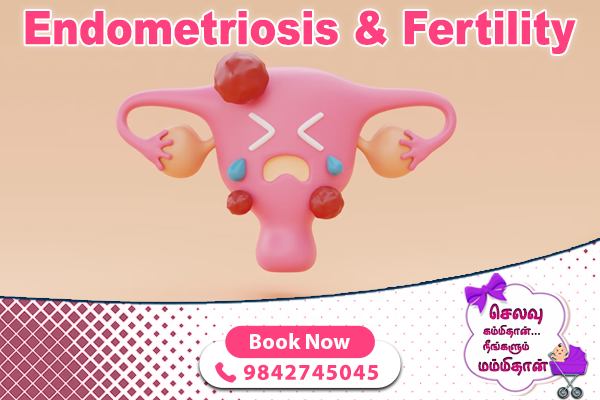Endometriosis is a condition where the tissue similar to uterine lining grows outside the uterus. Endometrium is a type of tissue that lines the inside of the uterus. During every monthly menstrual cycle, this lining gets thickened due to the hormonal influence. In a person with endometriosis, the abnormal tissue that grows outside the uterus is also influenced by the hormonal changes and behaves similarly. It thickens before ovulation and during menstruation, it swells and bleeds into areas it should not be.
The most common site of this extra endometrial tissue are the fallopian tubes and ovaries. So, the swelling and bleeding there may block the fallopian tubes and make it more difficult for a person to get pregnant. Endometriosis is primarily found in young women, but its occurrence is not related to any ethnic or social group.
HOW DOES ENDOMETRIOSIS AFFECT FERTILITY?
Though Endometriosis does not necessarily cause infertility, it can reduce the fertility in many individuals thus leading to difficulty in getting pregnant. Research suggests that more than 40% of women with infertility also have endometriosis.
Endometriosis is a progressive condition, which means it can gradually worsen over time. As more and more patches of endometriosis grow in the pelvic and abdominal areas, they can block the reproductive organs making it harder for sperm to reach the egg.
Endometriosis can affect fertility by:
- Difficulty in implanting of embryo
- Causing tubal scarring leading to blockage
- Affecting growth of the egg
- Creating hormonal imbalance
- Causing inflammation in the pelvis
SIGNS AND SYMPTOMS
Typically, endometriosis causes pain and infertility. Some may also complain of pelvic pain, dysmenorrhea and dyspareunia. 20 – 25% of individuals may be asymptomatic also. The symptoms of endometriosis do not always correlate with its laparoscopic appearance. The severity of endometriosis symptoms and signs usually increases with age with peak incidence in women of 40 years of age.
TYPES OF ENDOMETRIOSIS
There are 3 types of endometriosis depending on the extent of growth of the patches –
- Superficial peritoneal
- Endometriomas
- Deeply infiltrating
An individual can have one or more type. Additionally, endometriosis can be divided into stages. They range from I – IV with stage I being the least severe and stage IV the most severe type.
SUPERFICIAL PERITONEAL ENDOMETRIOSIS
Peritoneum is a thin film of tissue lining the abdomen. Sometimes endometrial tissue can be seen as growth or cyst in this layer leading to endometriosis. This type of endometriosis is usually classified as stage I or II type. Though it is the least severe type of endometriosis, it can still cause difficulty in conceiving.
ENDOMETRIOMAS
Endometriomas are cysts that grow on the surface of or inside the ovaries. These are also called as chocolate cysts due to the dark brown colour fluid inside it. This type is usually classified as stage III or IV and it greatly impacts a person’s ability to conceive. They can cause scar tissue on the fallopian tubes and ovaries leading to tubal block and ovulation issues.
DEEPLY INFILTRATING
This type of endometriosis is classified as stage IV type and refers to severe form of endometriosis. In this the endometrial like tissue grows on inner abdominal organs near the uterus like vagina, bladder, bowel etc. These individuals have extensive scarring in the ovaries, uterus or fallopian tube leading to difficulty in conceiving naturally, they might still be able to get pregnant with IVF treatment.
FERTILITY TREATMENT OPTIONS FOR ENDOMETRIOSIS
Several treatment options are available for people with endometriosis who have not become pregnant after 6 – 12 months of trying.
TREATMENT FOR STAGES I AND II
In the earlier stage of the condition, the person may nor require any treatment. However, the doctor might perform a simple procedure called laparoscopy to visualize the lesions as well as remove them surgically if necessary. (Laparoscopy is a surgical procedure where the doctor passes a probe with a camera through a small incision in the abdomen)
TREATMENT FOR STAGES III AND IV
In the later stages of endometriosis, it is difficult to get pregnant without additional assistance like IVF. For person more than 35 years, doctor might recommend combination of hormonal drugs with Intrauterine Insemination (IUI).
SUMMARY
Though endometriosis has an impact on a person’s fertility, it is not impossible for a person to get pregnant with endometriosis. People in early stages may be able to conceive without medical assistance, but they are likely to need medication, IUI or IVF in the later stages. For further assistance, contact our fertility experts at our centre.

